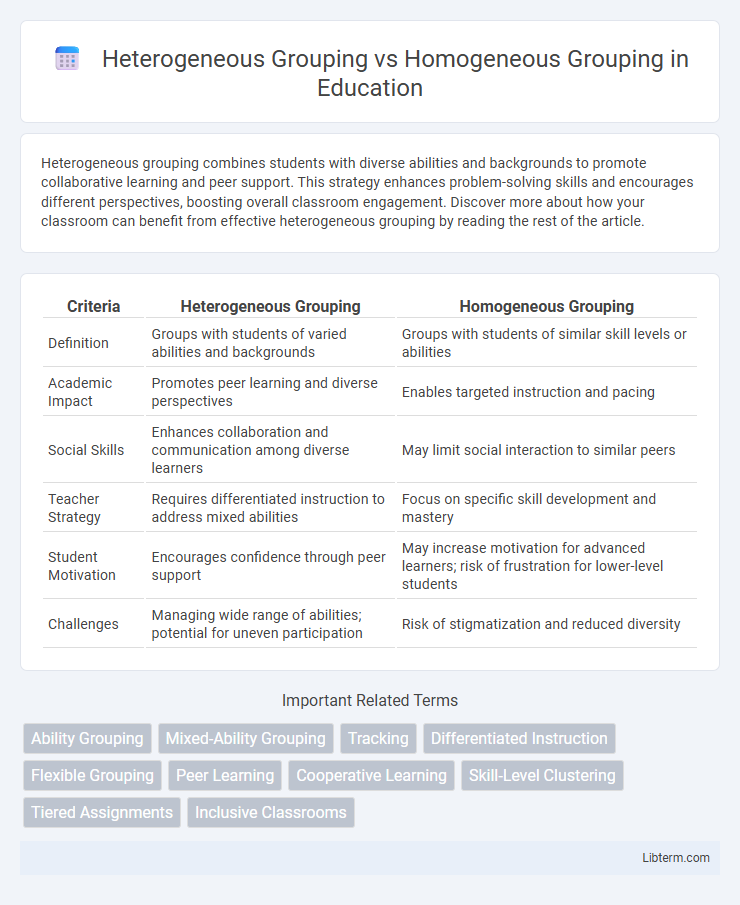Heterogeneous grouping combines students with diverse abilities and backgrounds to promote collaborative learning and peer support. This strategy enhances problem-solving skills and encourages different perspectives, boosting overall classroom engagement. Discover more about how your classroom can benefit from effective heterogeneous grouping by reading the rest of the article.
Table of Comparison
| Criteria | Heterogeneous Grouping | Homogeneous Grouping |
|---|---|---|
| Definition | Groups with students of varied abilities and backgrounds | Groups with students of similar skill levels or abilities |
| Academic Impact | Promotes peer learning and diverse perspectives | Enables targeted instruction and pacing |
| Social Skills | Enhances collaboration and communication among diverse learners | May limit social interaction to similar peers |
| Teacher Strategy | Requires differentiated instruction to address mixed abilities | Focus on specific skill development and mastery |
| Student Motivation | Encourages confidence through peer support | May increase motivation for advanced learners; risk of frustration for lower-level students |
| Challenges | Managing wide range of abilities; potential for uneven participation | Risk of stigmatization and reduced diversity |
Introduction to Student Grouping Strategies
Heterogeneous grouping combines students of varied abilities, learning styles, and backgrounds to promote peer learning and diverse perspectives. Homogeneous grouping clusters students with similar skills or achievement levels, allowing for targeted instruction and pacing suited to specific needs. Effective student grouping strategies balance these approaches to enhance engagement and optimize educational outcomes.
Defining Heterogeneous Grouping
Heterogeneous grouping involves organizing individuals with diverse abilities, backgrounds, or skill levels within the same group to enhance collaborative learning and problem-solving. This approach promotes exposure to varied perspectives, fostering critical thinking and social development. Research shows that heterogeneous groups improve academic achievement and cooperation compared to homogeneous grouping, where members share similar traits.
Understanding Homogeneous Grouping
Homogeneous grouping organizes students based on similar abilities, learning styles, or skill levels to tailor instruction more precisely and efficiently. This approach enhances targeted teaching strategies, allowing educators to address specific academic needs and promote mastery within each group. Research indicates that homogeneous groups can improve student confidence and accelerate learning progress by providing a more focused and supportive environment.
Key Differences Between Heterogeneous and Homogeneous Grouping
Heterogeneous grouping involves assembling individuals with diverse abilities, skills, or backgrounds, promoting varied perspectives and collaborative problem-solving, while homogeneous grouping clusters individuals with similar characteristics, enabling targeted instruction tailored to specific learning levels. Key differences include the impact on peer learning, with heterogeneous groups fostering peer support and knowledge sharing, and homogeneous groups facilitating focused skill development and minimizing distractions. Educators choose based on goals like enhancing critical thinking through diversity or accelerating mastery via uniformity in student readiness.
Benefits of Heterogeneous Grouping
Heterogeneous grouping enhances collaboration by bringing together diverse perspectives, skills, and experiences, fostering creativity and problem-solving abilities. Mixed-ability groups promote peer learning and support, enabling students to develop critical thinking and social skills through interaction with varied viewpoints. This approach prepares learners for real-world environments by encouraging adaptability and empathy in diverse teams.
Advantages of Homogeneous Grouping
Homogeneous grouping enhances targeted instruction by allowing educators to tailor lessons precisely to students' similar skill levels, boosting learning efficiency. It fosters a collaborative environment where peers with comparable abilities can engage more confidently, promoting deeper understanding and skill mastery. This grouping method simplifies assessment and progress tracking, enabling educators to implement focused interventions and accelerate student achievement.
Challenges and Limitations of Each Grouping Method
Heterogeneous grouping often faces challenges related to varying skill levels and learning paces, which can lead to disengagement or frustration among both advanced and struggling students. Homogeneous grouping may limit social interaction and reduce exposure to diverse perspectives, potentially hindering the development of collaborative and adaptive skills. Both grouping methods encounter limitations in addressing individual learning needs effectively while maintaining group cohesion and motivation.
Impact on Student Learning and Achievement
Heterogeneous grouping fosters diverse perspectives and collaborative problem-solving, enhancing critical thinking and social skills among students with varying abilities and backgrounds. Homogeneous grouping allows tailored instruction based on similar skill levels, which can accelerate learning for advanced students but may limit exposure to diverse viewpoints for others. Research indicates that heterogeneous groups often promote higher overall achievement and improved motivation by encouraging peer support and inclusive learning environments.
Best Practices for Implementing Grouping Strategies
Effective implementation of heterogeneous grouping involves combining students with diverse skills, backgrounds, and learning styles to promote peer learning and collaboration. Homogeneous grouping works best when tailored to target specific skill levels or needs, allowing for customized instruction and focused interventions. Best practices include clearly defining group objectives, regularly assessing group effectiveness, and maintaining flexibility to reassign groups based on ongoing student performance and engagement metrics.
Conclusion: Choosing the Right Grouping for Your Classroom
Selecting between heterogeneous and homogeneous grouping depends on your classroom goals, student needs, and learning objectives. Heterogeneous grouping promotes diverse perspectives and collaborative skills, ideal for fostering creativity and peer learning, while homogeneous grouping enhances targeted instruction and allows for tailored support to specific skill levels. Effective educators assess student dynamics and curriculum demands to implement the grouping strategy that maximizes engagement and academic growth.
Heterogeneous Grouping Infographic

 libterm.com
libterm.com